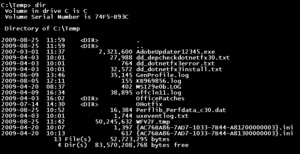Datotečni sistem
U računarstvu Datotečni sistem (engleski: file system) upravlja time kako se podaci pohranjuju i preuzimaju. Datotečni sistem je sposobnost pomoću kojeg operativni sistem upravlja podacima i njihovom organizacijom na disku ili particiji.[1][2] Svaka grupa podataka se naziva datoteka.
Datotečni sistem se može koristiti na brojnim različitim uređajima za skladištenje koji koriste različite vrste medija. Tvrdi diskovi su ključni uređaji za skladištenje i predviđeni su da ostanu kao takvi doglednoj budućnosti.[3] Druge vrste medija koji se koriste uključuju SSD-ove, magnetne trake i optičke diskove.
Neki datotečni sistemi koriste se na lokalnim uređajima za pohranu podataka;[4] drugi omogućavaju pristup datotekama putem mrežnog protokola (na primjer, NFS,[5] SMB ili 9P klijenti).

Datotečni sistemi u operativnim sistemima
[uredi | uredi izvor]Mnogi operativni sistemi uključuju podršku za više od jednog sistema datoteka. Ponekad su OS i sistem datoteka su čvrsto isprepleteni.
Linux
[uredi | uredi izvor]Linux podržava brojne datotečne sisteme, ali to su najćešće sistemi iz ext * porodice (ext2, ext3 i ext4), XFS, JFS i btrfs .
macOS
[uredi | uredi izvor]macOS (ranije Mac OS X) koristi Apple File System (APFS), koji je zamijenio sistem datoteka naslijeđen od klasičnog Mac OS-a nazvan HFS Plus (HFS +).
OS/2
[uredi | uredi izvor]OS/2 1.2 uveo je datotečni sistem visokih performansi (HPFS).
Microsoft Windows
[uredi | uredi izvor]
Windows koristi datotečne sisteme FAT, NTFS, exFAT, Life File System i ReFS (posljednji je samo podržan i upotrebljiv u Windows Server 2012, Windows Server 2016, Windows 8, Windows 8.1 i Windows 10).
FAT
[uredi | uredi izvor]Porodica FAT datotečnih sistema podržavaju gotovo svi operativni sistemi za osobne računare, uključujući sve verzije Windowsa i MS-DOS/PC DOS, OS/2 i DR-DOS. FAT je zbog toga popularan kao univerzalni format razmjene između računara i uređaja bilo koje vrste i starosti.
NTFS
[uredi | uredi izvor]NTFS, uveden sa operativnim sistemom Windows NT 1993, omogućio je kontrolu dozvola zasnovanu na ACL-u . Ostale osobine koje NTFS podržava uključuju čvrste veze, višestruko strujanje datoteka, indeksiranje atributa, praćenje kvota, šifriranje (vidi Bitlocker), kompresiju i oporavak ranijih verzija datoteka.
exFAT
[uredi | uredi izvor]exFAT je patentno zaštićen datotečni sistem sa određenim prednostima u odnosu na NTFS. exFAT je jedini potpuno podržani sistem u macOS i Windows operativnim sistemima koji mogu pohraniti datoteku veću od 4 GB.
Reference
[uredi | uredi izvor]- ^ "5.10. Filesystems". The Linux Document Project. Pristupljeno December 11, 2021.
A filesystem is the methods and data structures that an operating system uses to keep track of files on a disk or partition; that is, the way the files are organized on the disk.
- ^ Arpaci-Dusseau, Remzi H.; Arpaci-Dusseau, Andrea C. (2014), File System Implementation (PDF), Arpaci-Dusseau Books
- ^ "Storage, IT Technology and Markets, Status and Evolution" (PDF). 20. 9. 2018.
HDD still key storage for the foreseeable future, SSDs not cost effective for capacity
- ^ Arpaci-Dusseau, Remzi H.; Arpaci-Dusseau, Andrea C. (2014), File System Implementation (PDF), Arpaci-Dusseau Books
- ^ Arpaci-Dusseau, Remzi H.; Arpaci-Dusseau, Andrea C. (2014), Sun's Network File System (PDF), Arpaci-Dusseau Books
Dalje čitanje
[uredi | uredi izvor]Knjige
[uredi | uredi izvor]
- Arpaci-Dusseau, Remzi H.; Arpaci-Dusseau, Andrea C. (2014). Operating Systems: Three Easy Pieces. Arpaci-Dusseau Books.
- Carrier, Brian (2005). File System Forensic Analysis. Addison-Wesley. ISBN 0-321-26817-2.
- Custer, Helen (1994). Inside the Windows NT File System. Microsoft Press. ISBN 1-55615-660-X.
- Giampaolo, Dominic (1999). Practical File System Design with the Be File System (PDF). Morgan Kaufmann Publishers. ISBN 1-55860-497-9. Arhivirano s originala (PDF), 13. 2. 2017. Pristupljeno 22. 1. 2010.
- McCoy, Kirby (1990). VMS File System Internals. VAX - VMS Series. Digital Press. ISBN 1-55558-056-4.
- Mitchell, Stan (1997). Inside the Windows 95 File System. O'Reilly. ISBN 1-56592-200-X.[mrtav link]
- Nagar, Rajeev (1997). Windows NT File System Internals : A Developer's Guide. O'Reilly. ISBN 978-1-56592-249-5.
- Pate, Steve D. (2003). UNIX Filesystems: Evolution, Design, and Implementation. Wiley. ISBN 0-471-16483-6.
- Rosenblum, Mendel (1994). The Design and Implementation of a Log-Structured File System. The Springer International Series in Engineering and Computer Science. Springer. ISBN 0-7923-9541-7.
- Russinovich, Mark; Solomon, David A.; Ionescu, Alex (2009). "File Systems". Windows Internals (5th izd.). Microsoft Press. ISBN 0-7356-2530-1.
- Prabhakaran, Vijayan (2006). IRON File Systems. PhD dissertation, University of Wisconsin-Madison.
- Silberschatz, Abraham; Galvin, Peter Baer; Gagne, Greg (2004). "Storage Management". Operating System Concepts (7th izd.). Wiley. ISBN 0-471-69466-5.
- Tanenbaum, Andrew S. (2007). Modern operating Systems (3rd izd.). Prentice Hall. ISBN 0-13-600663-9. CS1 održavanje: nepreporučeni parametar (link)
- Tanenbaum, Andrew S.; Woodhull, Albert S. (2006). Operating Systems: Design and Implementation (3rd izd.). Prentice Hall. ISBN 0-13-142938-8. CS1 održavanje: nepreporučeni parametar (link)
Online
[uredi | uredi izvor]- Local Filesystems for Windows
- Benchmarking Filesystems Part II using kernel 2.6, by Justin Piszcz, Linux Gazette 122, January 2006
- Filesystems (ext3, ReiserFS, XFS, JFS) comparison on Debian Etch Arhivirano 13. 9. 2008. na Wayback Machine 2006
- Interview With the People Behind JFS, ReiserFS & XFS
- Journal File System Performance (outdated): ReiserFS, JFS, and Ext3FS show their merits on a fast RAID appliance
